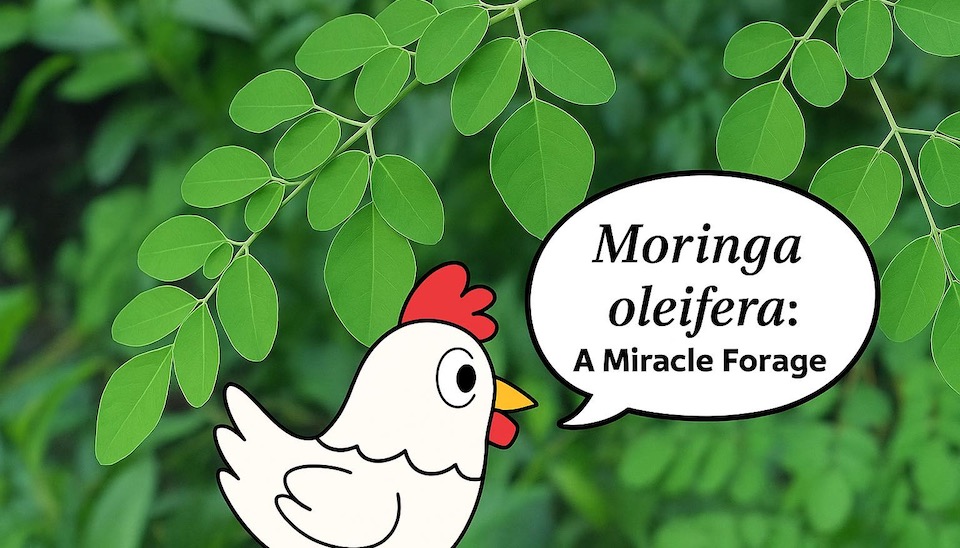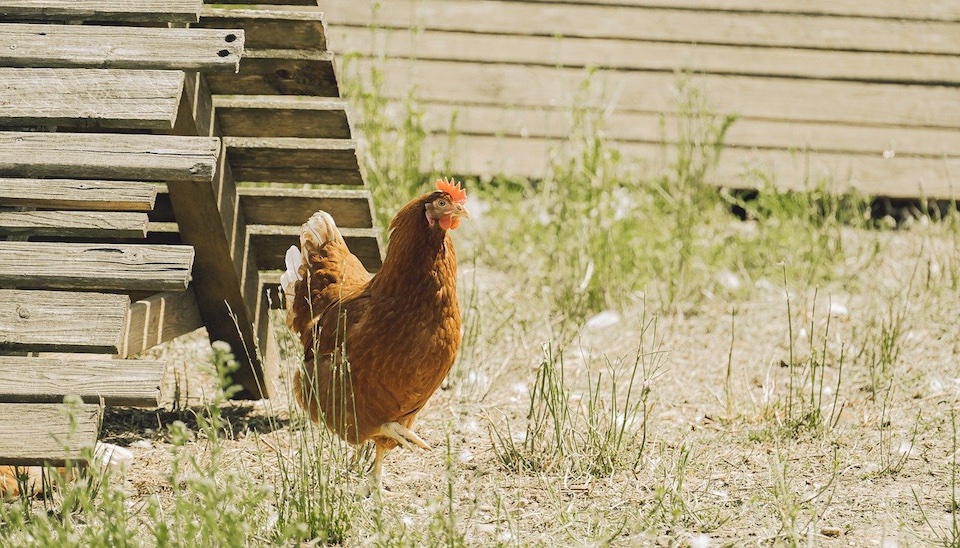Growing Moringa for Chickens
A Complete Guide to Moringa for Chickens
Moringa oleifera, also called Drumstick Tree and Miracle Tree, is easy-to-grow and suitable for most areas of Australia. High-protein foliage makes it a perfect backyard forage plant or addition to the chicken run. Furthermore, studies suggest that Moringa has the potential to enhance performance, improve egg quality and boost immunity in chickens.
Why grow Moringa for your chickens?
Moringa leaves are so nutritious that they are being used to combat human malnutrition as well as to feed livestock and poultry! So what are the benefits?
The nutritional benefits of Moringa oleifera leaves
- Protein: 29-38 % protein
Not only is this a high level of protein, particularly for green forage, but studies suggest it is bioavailable to chickens, meaning they are able to absorb all the nutritional benefits.
- Amino acids: Contains all of the essential amino acids for chickens
Moringa is rich in lysine, one of the two amino acids most critical for egg production, and it has essential amino acids similar to other plant-based proteins, such as soybean meal, which is often used in poultry feed.
- Vitamins: Rich in vitamins A, C, K and B (B1, B2, B3, B5 & B6)
The vitamins in Moringa support the immune system, nervous system and reproductive system. They are also good for metabolism, eyesight and blood health. B vitamins are essential for feather growth, particularly during moulting.
- Minerals: High levels of calcium, phosphorus, potassium, sodium, iron and zinc
Calcium is absolutely essential for laying hens, while phosphorous also contributes to eggshell and feather development. The other minerals in Moringa help support nerve function, the immune system, feather quality and hydration.
- Antioxidants: Contains polyphenols, flavonoids, carotenoids and phenolic acids
Antioxidants have a range of health benefits. In particular, they reduce the impacts of stress, improve immunity, enhance egg quality, and improve fertility. There are also suggestions that antioxidants can improve long-term health and performance. Plus, Moringa contains high levels of carotenoids, for vibrant yellow egg yolks.
How Moringa affects hen health and performance
Because of its nutritional benefits and easy cultivation, there has been a lot of research into using Moringa as a feed additive for poultry.
As with all scientific research, studies had different conditions and produced somewhat varied results. However, in general, adding Moringa to the diet of chickens provided the following benefits:
- Improved health: Moringa supports immune function and may also protect against toxins, for example from mouldy feed. It also has antibacterial and antimicrobial properties.
- Better egg quality: Adding Moringa to the diet led to lower egg cholesterol levels and more vibrant yellow yolks, as well as stronger eggshells less prone to breakage. In one study, it also increased levels of healthy omega 3 fatty acids in the eggs.
- Increased egg production: Moringa has the potential to increase egg production, especially in older hens.
- Better digestion: As well as improving gut health, Moringa is linked to better weight gain and improved feed conversion.
- A less smelly coop: One study found Moringa to decrease the amount of ammonia in droppings, meaning a fresher coop!
A note on scientific methods
In general, these benefits were obtained where Moringa made up between 1 % and 5 % of the diet. Most studies found that performance and egg production declined when Moringa intake was greater than this.
The studies usually used Moringa leaf meal (dried, ground leaves) either as a component of chicken feed, replacing other protein sources such as soybean meal, or as a proportion of the diet alongside a complete feed with balanced protein.
How to grow Moringa for chickens
Moringa oleifera will grow almost anywhere in Australia. It is fast-growing and requires little attention once established. Moringa trees can become very large, but regular pruning keeps them at a suitable size for a standard backyard.
Climate and Location
- Ideal Climate: Moringa thrives in tropical and subtropical climates. It will grow in arid and semi-arid areas, sometimes requiring irrigation. It will often become deciduous in the dry season. Moringa can grow in some temperate areas, where the tree is deciduous in winter.
- Temperature: Moringa prefers temperatures between 25°C and 35°C but can tolerate mild frosts once established. It can also cope with very hot temperatures once established, although additional water may be required.
- Soil: Prefers well-drained, sandy or loamy soil. Copes with poor soils but not waterlogging.
- Sunlight: Requires full sun for optimal growth.
- Rainfall: 250 to 3000 mm
Planting Moringa
Moringa is a great forage plant to grow for your chickens. It can be planted directly into your chicken run, but young trees do require protection from scratching and over-enthusiastic foraging. Moringa can also be planted alongside the chicken run, so that chickens can eat the foliage that grows through the fence, or can be planted in the yard and harvested regularly for your hens.
Moringa trees can get quite large - up to 12 metres high and 8 metres wide in ideal conditions. But they can be more shrub-like in marginal climates and locations, or if regularly pruned and harvested, making then suitable even for smaller yards.
Moringa makes a great hedge or windbreak with trimming and is also suitable for coppicing.
While Moringa grows quickly, particularly in the first 1-2 years, they tend to grow more slowly in less ideal conditions.
Cultivation
Moringa can be grown from seeds or cuttings.
Seeds are best started in a pot, but should be transplanted carefully and relatively early to avoid damaging the taproot.
Cuttings can be taken from sizeable branches (minimum 2 cm diameter) and planted directly into the soil. Cuttings will take best in mild weather and with regular watering.
Care and Maintenance
After they are established, Moringa plants will need very little attention and can thrive in most locations. In many cases, the only attention Moringa needs is regular harvesting to ensure it doesn't become too large.
- Watering: Water young plants regularly. Mature trees are drought-tolerant but benefit from occasional deep watering, particularly when it is dry or very hot.
- Fertilization: Apply compost or well-rotted manure during the growing season to promote healthy growth.
- Pruning: Regular pruning encourages bushier growth and makes harvesting leaves easier. Prune during dry weather to prevent disease.
Harvesting
Moringa leaves and branches be harvested once the tree is well-established. If you wish the tree to reach its full size, avoid harvesting until at least 1.5-2 m in height.
Earlier harvesting can encourage more shrub-like growth from Moringa plants.
Regular harvesting once established will encourage new growth.
Risks
Moringa is not yet considered a weed in Australia, although it has been found to naturalise in ideal areas, such as Northern Queensland. If you live in a tropical or subtropical area, particularly where the soil is not heavy clay, care should be taken to contain Moringa in your yard. This is particularly important on larger properties and near bushland.
Moringa can root from discarded prunings even months after they were originally cut, so take care that prunings and seeds do not spread. The easiest solution is making sure they all go into the chook pen, which has the added benefit of providing a high-quality forage for your chickens!
Using Moringa with chickens
All parts of the Moringa oleifera plant are edible, which is why it is sometimes called the Miracle Tree. Poultry can consume Moringa leaves, seed pods and seeds. The long seed pods are the source of another name for the plant: Drumstick Tree.
How the poultry industry uses Moringa
In the scientific studies where Moringa showed the most benefits for chickens, it usually made up about 1 % of the diet.
Most studies of the benefits of Moringa for poultry utilise leaf meal, which is just dried, ground leaves. The leaf meal is added to the feed, or provided in a separate dish for chickens to eat freely.
Using Moringa in the backyard chicken coop
While Moringa is a highly nutritious poultry feed, it is not a replacement for chicken feed. It cannot meet all of the nutritional requirements of your chickens and it remains necessary to provide free-access to a complete layer feed in addition to Moringa.
For most backyard chicken keepers, the easiest way to use Moringa is to allow chickens to eat the fresh foliage. You can:
- Plant Moringa in or adjacent to the chicken run and allow your birds to harvest it themselves (once it is established)
- Harvest branches and hang them in the coop or run for chickens to peck at
- Harvest leaves and mix them with feed or scraps
Fresh leaves spoil quickly and should be discarded at the end of the day.
You can also make leaf meal at home by hanging Moringa branches in the shade and then grinding the leaves. However, this will only work in low humidity areas – otherwise you would need to put the leaves in a dehydrator. Leaf meal can be added to feed or provided free-choice.
Conclusion
Incorporating Moringa oleifera into poultry diets offers multiple benefits, including enhanced performance and health. It is an easy plant to grow and will suit almost any location, so why not add it to the forage options in your backyard?
Want to read more about poultry forage?
- What are the best high-protein forage greens to grow for your chickens?
- How does forage fit into a balanced diet? Our Complete Guide to Feeding Backyard Chickens can help!
- The best dual-purpose plants for the chicken run
Happy chicken keeping!
Rachael at Dine-A-Chook Australia



